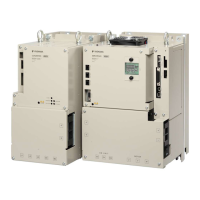
Do you have a question about the YASKAWA Sigma-V Series and is the answer not in the manual?
| Model | Sigma-V Series |
|---|---|
| Category | Servo Drives |
| Output Power | 0.05 kW to 55 kW |
| Communication | MECHATROLINK-II, MECHATROLINK-III, EtherCAT |
| Feedback | Incremental Encoder, Absolute Encoder |
| Protection Features | Overcurrent, Overvoltage, Undervoltage |
| Vibration | 5.9 m/s² or less |
| Storage Temperature | -20°C to 65°C (-4°F to 149°F) |
Overview of Σ-V series SERVOPACKs and converters for high-precision positioning.
Identifies and describes the various parts of the SERVOPACK.
Identifies and describes the various parts of the converter.
Details the technical ratings and specifications for SERVOPACKs and converters.
Provides internal block diagrams for both 200 V and 400 V configurations.
Illustrates typical system configurations for servo drives, including wiring.
Explains the coding system used for designating SERVOPACK models.
Explains the coding system used for designating converter models.
Lists compatible combinations of servomotors, SERVOPACKs, and converters.
Outlines procedures for inspecting and maintaining SERVOPACKs and converters.
Introduces the panel operator, its display, and keys for operation.
Details the utility functions available via the panel operator for setup and adjustment.
Explains parameter classification, notation, and setting methods for operation.
Describes how to view monitor displays for status and internal states.
Covers terminal names, specifications, wire types, and crimp terminals.
Details connector and terminal connections between converter and SERVOPACK.
Explains names and functions of I/O signals and provides connection examples.
Describes how to allocate input signals and check factory settings.
Shows connection examples for analog input, position reference, and safety input circuits.
Explains encoder signal names, functions, and connection examples (incremental/absolute).
Guides on selecting and connecting regenerative resistor units and setting capacity.
Covers selection and connection of dynamic brake units and resistors.
Details wiring for noise control and DC reactor connection for harmonic suppression.
Lists essential checks for servomotors, SERVOPACKs, and converters before trial operation.
Describes trial operation of servomotor without load, referring to external manuals.
Details trial operation using references from a host controller, covering speed and position control.
Outlines trial operation steps with the servomotor connected to the machine.
Provides precautions and procedures for trial operation of servomotors with brakes.
Explains the test without motor function for checking host controller and peripheral device operations.
Describes supported control methods and their selection via parameter Pn000.1.
Covers essential settings like Servo ON signal, servomotor rotation, overtravel, and holding brakes.
Details basic settings for speed control, including reference input and filters.
Explains basic settings for position control, including pulse train references and electronic gear.
Covers basic settings for torque control, including reference input and filters.
Describes operation using internal set speeds controlled by input signals.
Explains how SERVOPACK can switch between control methods.
Details methods for limiting output torque to protect the machine.
Explains the use of absolute encoders for position detection without zero point return.
Explains other output signals like servo alarm, warning, and rotation detection signals.
Details the safety function, including Hard Wire Base Block (HWBB) and external device monitor.
Outlines adjustment types and the basic procedure for optimizing responsiveness.
Explains the tuning-less function for obtaining stable response without manual adjustment.
Describes automatic adjustment of servo system parameters based on mechanical characteristics.
Details automatic tuning using position reference inputs from the host controller.
Manual tuning of level adjustments using position or speed reference inputs.
Enhances vibration suppression effectiveness, particularly for frequencies from 100 to 1000 Hz.
Suppresses transitional vibration at low frequencies (1 to 100 Hz), especially during positioning.
Covers functions for fine-tuning after autotuning, like gain switching and friction compensation.
Explains compatible functions from earlier models like feedforward and mode switching.
Lists all available utility functions with their operations and reference sections.
Displays the last ten alarms, including alarm numbers and time stamps.
Checks servomotor operation under speed control without host controller connection.
Positions the origin pulse of the incremental encoder and clamps at the position.
Allows continuous operation based on preset patterns for trial or simple positioning.
Resets parameters to factory settings after they have been changed.
Deletes all recorded alarm history from the SERVOPACK.
Displays servomotor model, voltage, capacity, and encoder type/resolution.
Checks the SERVOPACK and encoder software version numbers.
Clears alarms related to option module installation status.
Detects and adjusts vibration detection levels for accurate alarm output.
Sets the current position of the external absolute encoder as the origin.
Resets the SERVOPACK internally from software without restarting.
Detects resonance frequency and automatically sets notch filters for high-frequency vibration.
Detects machine vibration and automatically makes notch filter settings.
Lists available monitor displays for I/O signals and internal status.
Explains how to view monitor display contents, such as motor speed.
Describes how to read 32-bit data displayed in decimal format.
Checks the status of input signals using the input signal monitor (Un005).
Checks the status of output signals using the output signal monitor (Un006).
Checks the status of safety input signals using the safety I/O signal monitor (Un015).
Describes system configuration and connection for fully-closed loop control.
Provides the internal block diagram for fully-closed loop control.
Details the specifications and characteristics of the serial converter unit.
Shows connection examples for various external encoders like Heidenhain, Renishaw, Mitutoyo, Magnescale.
Outlines parameter settings required for fully-closed loop control.
Describes troubleshooting in response to alarm displays, including causes and corrective actions.
Details troubleshooting in response to warning displays, including causes and corrective actions.
Provides guidance for troubleshooting malfunctions based on servomotor operation and conditions.
Shows connection examples for various host controllers like OMRON and MITSUBISHI.
Lists all available parameters and their settings.
Lists all available monitor displays (Un□□□) for checking status.
Provides a table to record parameter settings for future reference.
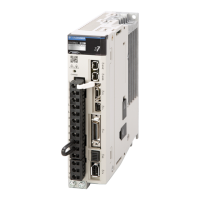
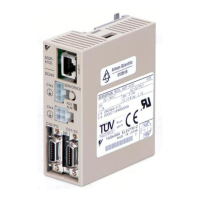
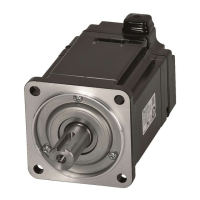
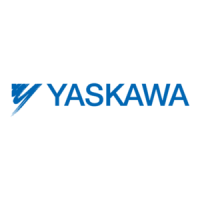
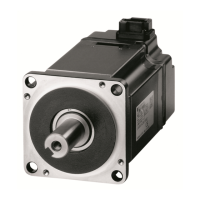
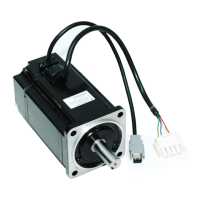




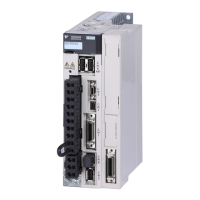

